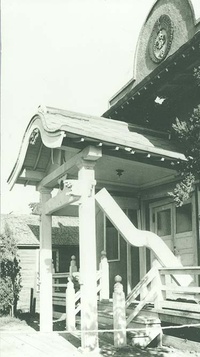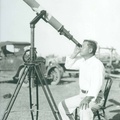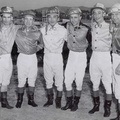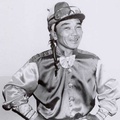Takanori “Pro” Nimura never forgot the 1927 earthquake because of the auspicious day on which it struck—January 1. In the Nimura family’s small moveable house in rural Calexico, his mother had stayed up all night preparing special New Year’s delicacies (Osechi-ryori), but the kitchen table toppled over during the earthquake and all of the food ended up upside down on the floor! The magnitude 5.8 quake was centered in Mexicali and it killed fifteen people.
Not all Nisei remember the New Year’s earthquake, but the earthquake that is forever etched in the memories of those who experienced it occurred on Saturday, May 18, 1940. It was in actuality a series of nineteen tremors along the San Andreas Fault. The largest of the quakes struck at 8:37 p.m. and hit the town of Imperial the hardest. While the U.S. Geological Survey lists its magnitude between 7.0 and 7.1, the Southern California Earthquake Data Center recorded the quake at a downgraded level of 6.9. It was followed by a magnitude 5.5 earthquake about two hours later centered in Brawley. Aftershocks continued to rattle the valley until the next morning. The day after the earthquake, the Imperial Valley Press gave an account of six individuals who had been killed—one in El Centro, four in Imperial, and one in Brawley. In the words of the reporter, “Death struck from the bowels of the earth.” All six persons perished under the debris of bricks and wooden beams, as the buildings they were in, or fleeing from, collapsed. The official death toll was later raised to nine and several additional fatalities were indirectly attributed to the earthquake. Local hospitals were inundated with the injured.

This photograph was taken along Eighth Street in Brawley shortly after the 1940 earthquake. Across from Miharu Hosokawa’s New Brawley Hotel and Shintaro Tamaru’s Asahi Company, the Hotel Woodrow (right) was a two-story building that collapsed during the earthquake. According to local folklore, on the fateful night a patron went to bed on the second floor and woke up on the first! (Photo courtesy of Japanese American Gallery, Imperial Valley Pioneers Museum)
The material damage was substantial, estimated at $6 million countywide. Buildings crumbled, minor fires broke out, water towers collapsed, windows shattered, bridges went out, and power lines were downed. The earthquake caused several traffic accidents as drivers momentarily thought that they had flat tires then lost control of their vehicles. Paved roads buckled and the cracks in some roads were so wide that they were impassable. Damage was also done to the railroad lines.
Twelve-year-old Tatsuo Asamen was irrigating a field of honeydew melons for his father when the earthquake struck. He witnessed waves of water crash through irrigation canals and wash away furrows. “I just walked home; there was nothing I could do,” he recounted. The Alamo Canal, the main channel that supplied water from the Colorado River to the Imperial Valley, was damaged causing an interruption in irrigation for eight to ten days. On May 20, the Kashu Mainichi reported that Issei melon growers who customarily irrigated their fields every other day once the temperature exceeded 100 degrees feared that the water stoppage would cause crop losses. Even though diversionary ditches were put into operation until repairs were made to the canal system, some melon crops that were dry at the time of the earthquake—particularly those fields closest to the fault line—did wither away.

Damage done to the El Centro Buddhist Church during the 1940 earthquake. After the initial shock, to protect the church’s gold statue of Amida Buddha, Rev. Kakumin Fuji-naga wrapped the sculpture in a blanket and carried it out to his car. He let the air out of the tires so the car would not move. Rev. Fujinaga sat in the car cradling the statue in his arms throughout the night. (Photo courtesy of Japanese American Gallery, Imperial Valley Pioneers Museum)
There were no reported deaths among the valley’s Japanese Americans, but Takumaro Ariura in El Centro and Shosaku Neeno of Brawley were severely injured. Among the buildings damaged in El Centro was “Doc” Momita’s drug store with at least $2,000 in damage. In Brawley, thirty-four Nikkei businesses reported severe damage estimated at $60,000. Those that were hardest hit included the Mikado Café, Union Drug Store, Cash Grocery, Oda Pool Hall, Asahi Company, Kubota Café, New Brawley Hotel, and Nakamura Boarding House. Parts of the walls of the Brawley Japanese Methodist Episcopal Church crumbled down and its roof sagged. During the first major earthquake, Jiro Yamasaki and his diners fled from his Mikado Café. Yamasaki was so determined to go back into his café to retrieve the contents of his safe that he had to be physically restrained by his friends. As he was being held back, an aftershock caused the walls and roof of the building to come crashing down. Had he reentered his café, it is doubtful that he would have survived. The safe was later dug out from under the rubble, unscathed.
Emergency aid and support from within the Nikkei community, as well as from outside sources, quickly materialized during the time of crisis. The El Centro Buddhist Church and Brawley Buddhist Church received donations from Buddhist youth organizations throughout Southern California. And in Brawley, under the direction of the Japanese Association, the Buddhist Church and Japanese Methodist Episcopal Church collaborated in organizing a community kitchen to feed those unfortunate families that were left without cooking facilities.
--------------------------------------------------------------------------
Major Earthquakes in the Imperial Valley
<Date> <Magnitute>
February 24, 1892 7.8
April 18, 1906 6.2
June 22, 1915 6.3
May 28, 1917 5.5
May 1, 1918 5.6
January 1, 1927 5.8 (Mexicali, Mexico)
May 18, 1940 7.0-7.1
October 15, 1979 6.4
April 26, 1981 6.0
November 23, 1987 6.7
April 4, 2010 7.2 (Baja Calif., Mexico)
--------------------------------------------------------------------------
* This article was originally published on the Teikoku Heigen News: Newsletter of the Japanese American Gallery (Spring 2010, Number 24).
© 2010 Tim Asamen





